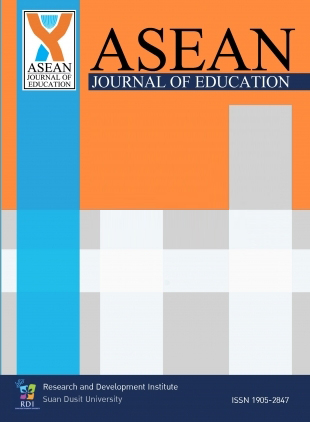Development of an English Language Instructional Model based on the 21st Century Learning Skills to Enhance ELLs’ Learning Achievement
Keywords:
The 21st Century learning skills, English language teaching and learning in 21st Century, ELLs’ learning achievementAbstract
With the rapid changes in the world, many educators attempt to find effective ways to support learners’ academic and professional achievement. 21st Century learning skills support and respond to the changes such as to encourage learners’ creativity, critical thinking, communication and collaboration. With this in mind, being teachers in the 21st Century learning is not easy and it is necessary to understand the clear picture of 21st Century learning skills. The understanding of ideas for 21st Century skills are recognized as standard of education process because it will affect education practice, for instance, setting classroom management, goals and learners’ desirable skills of learners. Teachers who can implement the concept of 21st Century skills conduct the instruction effectively. Accordingly, the instructional model is produced in order to support the teachers in understanding and implementing. The objectives of the study were 1) to develop an English language instructional model based on the 21st Century learning skills to enhance learning achievement and 2) to examine the quality of an English language instructional model based on the 21st Century learning skills to enhance ELLs’ learning achievement. The research instruments used in the study were semi-structured interview forms and the 21st Century learning skills checklist. The findings of the study revealed that, for the development of the English language instructional model based on the 21st Century learning skills: there were ten components as follows; setting up objectives, analyzing the environment, analyzing the learners’ role, analyzing the teacher’s role, analyzing and designing content, identifying instructional strategies, developing and selecting instructional materials, designing instructional procedures, evaluating the learning outcome and providing feedback. Regarding the examination of the quality of the English language instructional model based on the 21st Century learning skills, it was found that the consistency of the components of the instructional model was 0.96 which represented that the English language instructional model was consistent with all components. When it was considered in terms of the appropriateness of the components’ description, it reached 0.98 which shows that it was appropriate to employ in teaching and learning.
References
Baxter, W. (2017). Thailand 4.0 and the future of work in the Kingdom. Retrieved May 16, 2021, from http://www.ilo.org/wcmsp5/groups/Public/---dgreports/---dcomm/documents/meetingdocument/wcms_549062.pdf
Beers, S. (2011). Teaching 21st Century skills: An ASCD action tool. Virginia: ASCD.
Bellanca, J. et al. (2010). 21st Century skills: Rethinking how students learn. Indiana: Solution Tree Press.
Briggs, L.J., Kent, L.G., & Tillman, M. H. (1991). Instructional design: Principles and applications. (2nd eds.). New Jersey: Educational Technology.
Covili, J. (2012). Going Google: Powerful tools for 21st Century learning. California: Corwin.
Good, T. (2008). 21st Century education: A reference handbook. California: SAGE. Hallissy, M. et al. (n.d.). Redesigning education: Meeting the challenges of the 21st Century. Retrieved May 16, 2021, from http://www/file.///C:/Users/ASUS/Downloads/ms-learning-paper-book.pdf
Marzano, R., & Heflebower, T. (2012). Teaching & assessing 21st Century skills. Indiana: Marzano Research Laboratory.
Mercado, L.A. (2017). Technology for the Language Classroom: Creating a 21st Century classroom. New York: Macmillan.
Metzler, M. (2017). Instructional models in Physical education. New York: Routledge.
Pacific Policy Research Center. (2010). 21st Century skills for students and teachers. Honolulu: Kamehameha. Partnership for 21st Century Learning. (2016). Framework for 21st Century learning. Retrieved May 16, 2021, from http://www.p21.org/storage/documents/docs/P21_framework_0816.pdf
Partnership for 21st Century Skills. (2008). 21st Century skills, education & competitiveness. Retrieved May 16, 2021, from http://www.p21.org/storage/documents/21st_century skills_education_and_competitiveness _guide.pdf
Pearson. (n.d.). English learners in 21st Century classrooms. Retrieved May 16, 2021, From https://www.pearsonhighered.com/assets/samplechapter/0/1/3/2/0132685159.pdf
Puncreobutr, V. (2016). Education 4.0: New challenge of learning. Theresa Journal of Humanities and Social Sciences, 2(2), 92-97.
Rushby, N., & Surry, D. W. (2016). The Wiley handbook of learning technology. West Sussex: John Wiley & Son.
Saylor, G.J.,Alexander, W.M., & Lewis,A.J. (1981). Curriculum planning for better teaching and learning. (4th eds.). New York: Holt, Rinehart and Winston.
Tan, O., Liu, W., & Low, E. (2017). Teacher education in the 21st Century: Singapore’s evolution and innovation. Singapore: Springer Nature.
Turkkahraman, M. (2012). The role of education in the societal development. Journal of Educational and Instructional Studies in the World, 2(4), 38-41.
Downloads
Published
How to Cite
Issue
Section
License

This work is licensed under a Creative Commons Attribution-NonCommercial-NoDerivatives 4.0 International License.
1 All articles will undergo a formal peer-review. A panel of experts from within or without the university will examine the article; approval from a minimum of two experts is required for publication. Revisions posed by the experts must be completed by the research prior to publication.
2 Once published in the ASEAN Journal of Education, the article becomes intellectual property of Suan Dusit University. Duplication, in full or part, requires permission from Suan Dusit University.
3 Excluding errors incurred during printing, author(s) are responsible for the content of their articles.





